Auroville’s Forests through Time
When Auroville was founded in 1968, the area was a mix of dry canyons and farmland cultivated by Tamil people, after centuries of colonialism and resource extraction. European companies had decimated the local indigenous forests, causing excessive topsoil erosion during the annual monsoons.
Early Aurovilians set about working with the local people to reverse the course of ecological degradation. Over time and through intensive experimentation, they have developed a profound and unique understanding of how to rebuild an ecosystem. They learned how to prevent erosion and topsoil loss, planted hardy deep-rooting trees to begin, and eventually started seeking out and integrating species native to the Tropical Dry Evergreen Forest, a rare forest type native to the coastal belt of Tamil Nadu. Today, millions of trees have been planted and the ecosystem has rebounded to an incredible extent.
Read More about Auroville’s Forests on the Auroville.org Forests & Biodiversity page and scroll below for a list compiled by us.
To learn more about Auroville’s Forests, watch the movie Ever Slow Green, by Aurovilian Christoph Pohl, a beautiful documentary that describes the history of Auroville’s reaforestation.
AUROVILLE’S FORESTS
Nine Palms
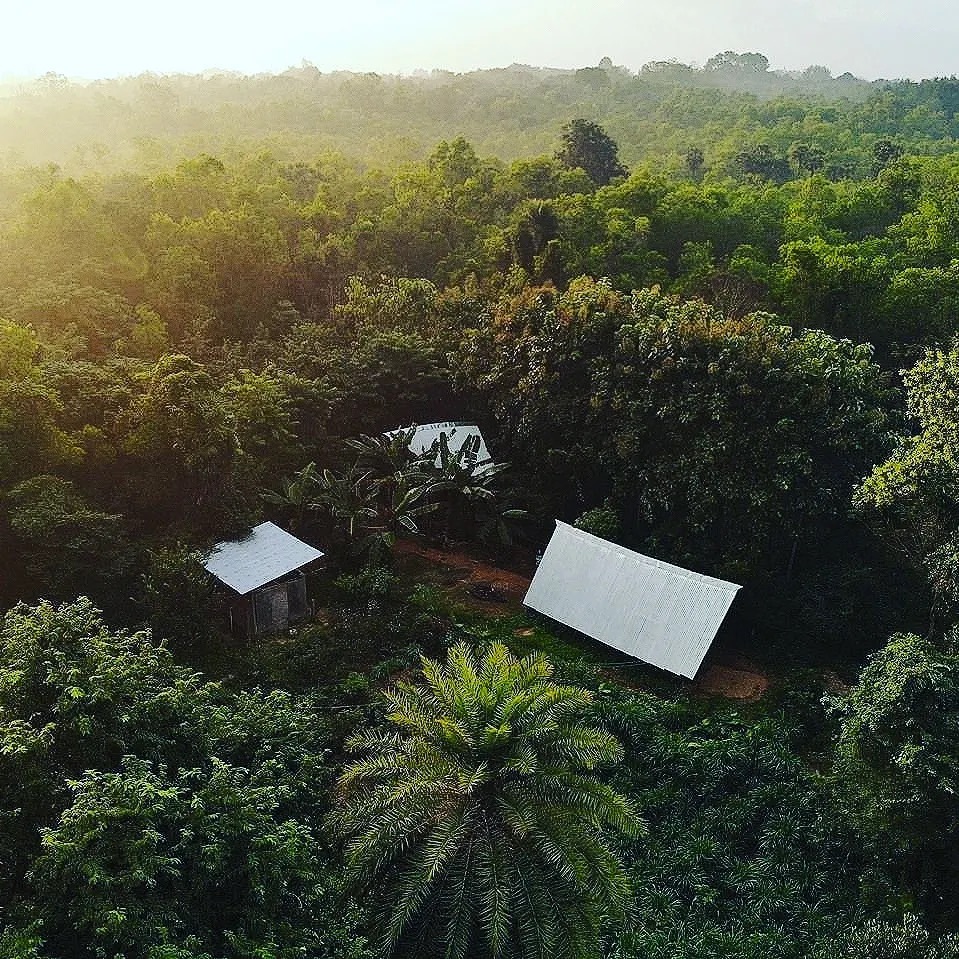
9 Palms was founded in 1973 when Klaus and Ingrid settled on the dry, barren, and eroded land. The area, which once lacked its own direct water supply, is now one of the biggest forest communities dedicated to water conservation in the area. They have built 5 dams and several smaller water-catchment areas over the years which help to replenish the town’s aquifers. 9 Palms also has a yearly tree planting program through which 2500 new saplings are planted annually through the efforts of volunteers and school programs.
Stewards: Shanti, Ananda and Shivaji
Contact: Shanti av2788@bk.ru
Baraka

Once known as Fertile Windmill, Baraka is made up of 40 acres of forested land and 5 acres of orchards and residential areas. The current steward, Achilles, is responsible for transforming the land and restoring buildings after years of neglect. From April until August, Baraka is busy harvesting tamarind, mangos, and pineapple to be shared with the community. What is not shared becomes delicious jams. Other produce that is harvested throughout the year are lemons, papaya, green pepper, guavas and custard apples. Baraka is also responsible for planting approximately 1,000 seedlings per year.
Steward: Achilles
Contact: equilibrium333@gmx.de
Bliss Forest

Bliss Forest is a young and densely planted area located north of the Matrimandir and administration zone, in the central city area. This 30 year-old patch of forest is an excellent demonstration of the process called Ecological Succession, where the native evergreen canopy is by now dense enough so that pioneer species like the work tree (Acacia auriculiformis) hardly regenerate any longer. The area started being planted with Tropical Dry Evergreen (TDEF) species in the early 90s. Bliss forest then grew around the newly born Youth Center. The development and management of the Youth Centre and Bliss Forest are interlinked; the youth help in seasonal planting and occasionally maintenance work on the land.
Stewards: Christoph, Elumalai, Manolo
Contact: blissforest.auroville@gmail.com
Discipline

Joster, Meike and Edzard settled in 1976 in what was to become the Discipline community. The land was desolated, as most were in those early days in Auroville. Today, Discipline consists of two diversely managed areas. One is dedicated to farming and residential and takes up approximately 40% of the land. The other is dedicated to forestry and comprises 60% of the remaining land. Twelve water harvesting ponds have been dug in the farm while in the natural ravine between 9 Palms Community and Discipline, a series of 2 dams and many smaller check dams were constructed.
Steward: Edzard
Contact: eloesing9@gmail.com
Eternity
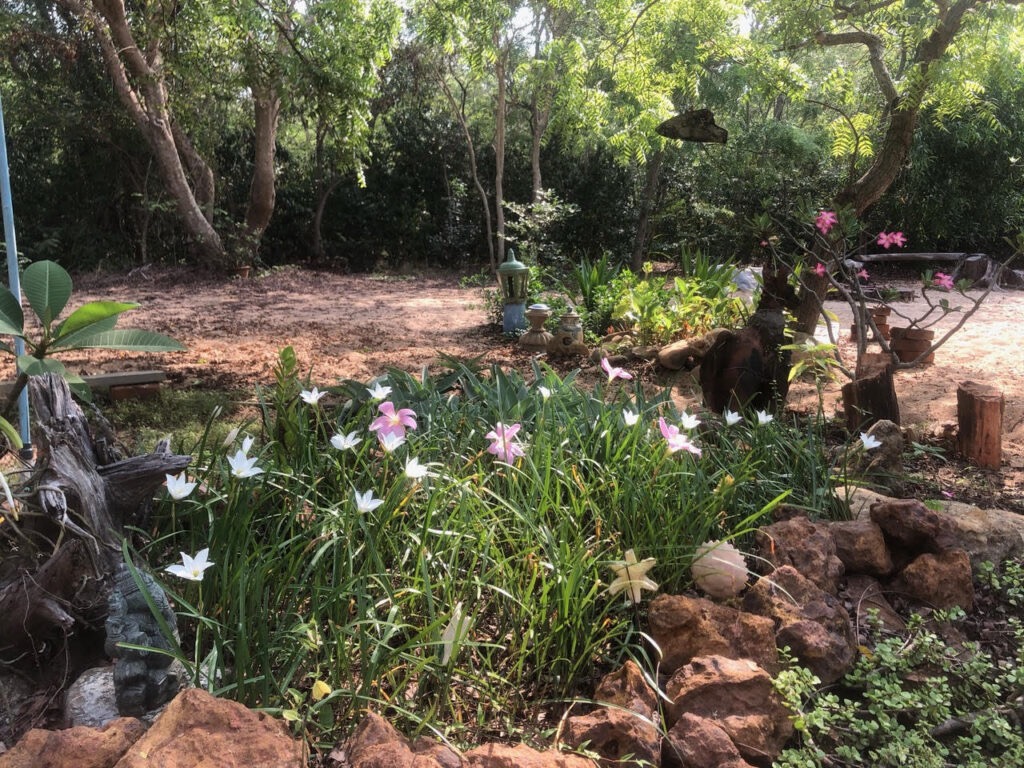
Eternity was once a barren sand dune but is now a lush forest on the coast made up of 18.5 acres. n the past, the Eternity community had Coconut plantations and other fruit orchards, however, now the forest and fruit trees have merged. This has been a conscious move from the part of the steward; it has reduced the crop greatly but has increased wildlife also. The Eternity community was greatly affected by the Tsunami of 2004 and still feel the effects in the lack of clean water in their water table. One of their takeaways from the natural disaster, however, was planting more varieties of trees that survived the effects of the Tsunami.
Steward: Jonah
Contact: eternaljonah@gmail.com
Evergreen Forest
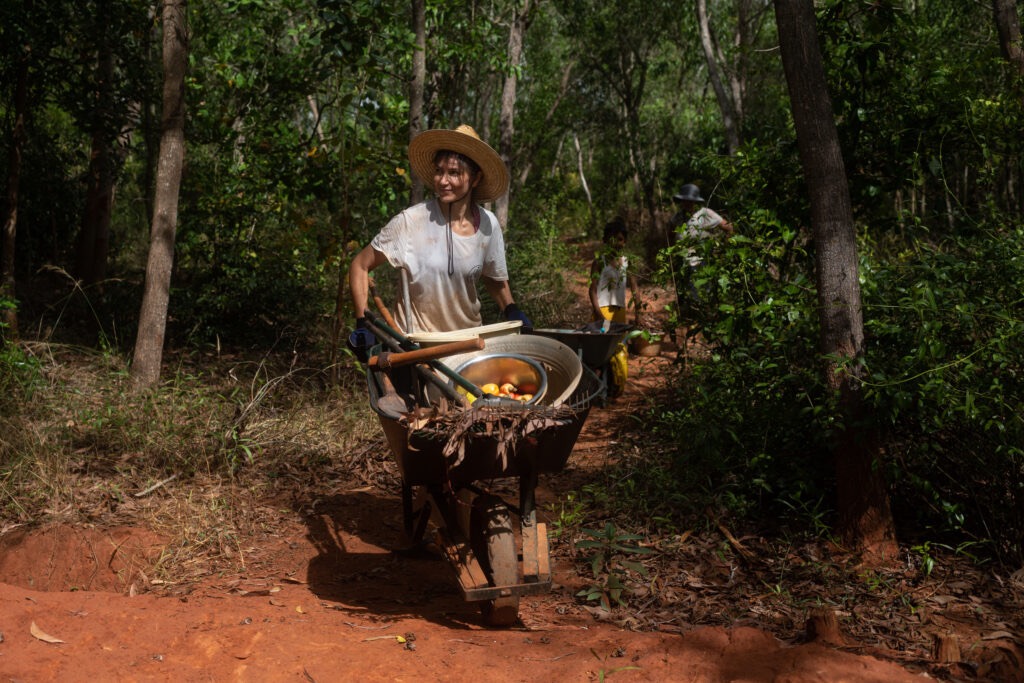
Evergreen, as the name suggests, is a forest with trees that largely stay green throughout the year and are considered by some as symbols of the eternal. Santo first planted these trees in 1993 soon after the land was bought by Auroville. Through changing hands and moving boundaries the main impetus for the work has remained the same. Namely to restore the Tropical Dry Evergreen Forest (TDEF) that once filled the entire Auroville plateau. This entails increasing biodiversity, ensuring representation of over 400 species, protection and maintenance of habitat, soil and water conservation and a general adaptive management to this growing forest ecosystem.
Steward: Natasha Storey
Contact: natsstorey@gmail.com, eilocna@gmail.com
Fertile

Fertile started as a community settlement in 1972. It was one of the first reforestation communities along with Forecomers. During the first 10 years the main focus was reforestation but has evolved into an “informal” campus of vocational training, social and educational center that organizes field trips, cultural exchanges, and informal learning for children and adults alike. The Fertile community hosted and organized the “Water Mela” (Mela means Festival) in November 2021, that held presentations from various experts, many informative panels, demonstrations and action plans. Fertile is also one of the main promoters and organizers of the “Endangered Craft Mela”, where craftsmen/women from the bioregion and Auroville are invited to showcase their particular crafts.
Steward: Johnny
Contact: johnnyidli@gmail.com
Fertile East
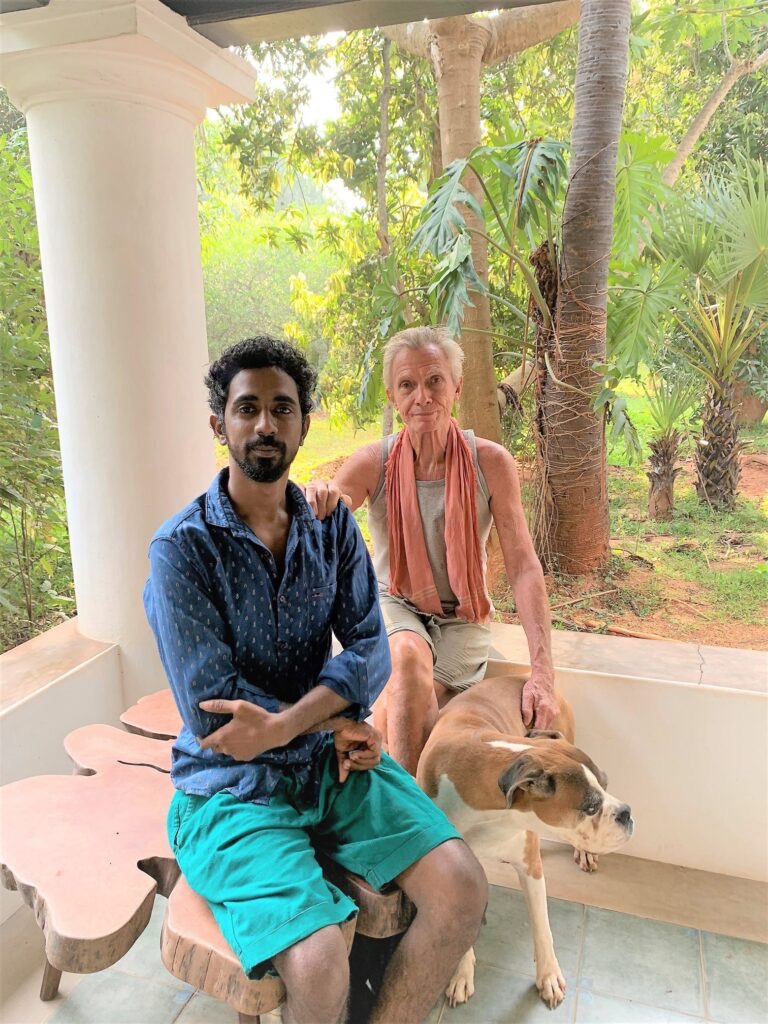
Fertile East was established in 1973 and began with no water, electricity, or trees. It is now approximately 12 acres and is part orchard and residential area, while the other is kept as a sanctuary with minimal human intervention, where the forest is left to take care of itself and ecological succession takes place. The main orchard consists of mango and citrus trees. The harvest is shared, free of charge, within the larger Auroville community.
Stewards: Heidi and Patrick
Contact: blumel.heidi@gmail.com
Fertile Field

Fertile Field was started in 1996 when Jana took up the stewardship of what was then mostly barren land and a young cashew plantation. The forest has been “designed” by Jana, an entomologist, for the preservation and reintroduction of insects; selecting trees and bushes varieties and establishing meadows and open fields that most appeal to specific butterflies and other insects. The forest has grown from 20 acres to 40 and is home to approximately 20.000 evergreen seedlings. These are enough to supply the Northern Forests of Auroville (NFA) and many other Auroville communities. The nursery is part of a collective project called NFA which Jan runs together with some other foresters of the northern area.
Stewards: Jana and Jan
Hermitage

Purchased in 1964, the land that is now Hermitage was one of the first parcels acquired for Auroville. It is situated about 7.5 km southwest of the center of Auroville in the tail of the Auroville “galaxy” and consists of approximately 74 acres, primarily canyon land: a starkly beautiful landscape now home to a rich variety of wildlife. Hermitage’s main areas of focus are soil and water conservation, reforestation, preservation of biodiversity, wetland creation and protection, creation of a protected area for wildlife, and protection of endangered species. In the area of water conservation, they have completed 26 earth check-dams with a cumulative length of more than 800 meters and an average height of 6 meters. Their combined water holding capacity totals several hundred thousand cubic meters; an area of approximately 40 acres underwater when in full capacity.
Stewards: Bernd and Andreanne
Contact: bernd@auroville.org.in, n.andreanne@gmail.com
Infinity

Infinity initially started as a project to supply the raw material needs of the Bamboo Center but under the current stewardship of Vikram and Andrey, has been planted with Tropical Dry Evergreen species. Infinity consists of 4 separate plots, the main area is right beside a large water catchment pond of the nearby village. In the last years Infinity had built 3 dams/large ponds to increase the percolation and water level in the area. Infinity at the moment consists of one large contiguous forest zone (sanctuary), one accommodation, one storeroom, a chicken house, a small farming area, a fruit orchard, a bamboo grove, and a managed forest zone. In the future, the stewards hope to improve the infrastructure, fence the farmed plot, and improve soil conditions to ultimately develop a food forest and provide accommodations for long term volunteers.
Stewards: Andrey and Vikram
Contact: av2788@bk.ru
Mango Field
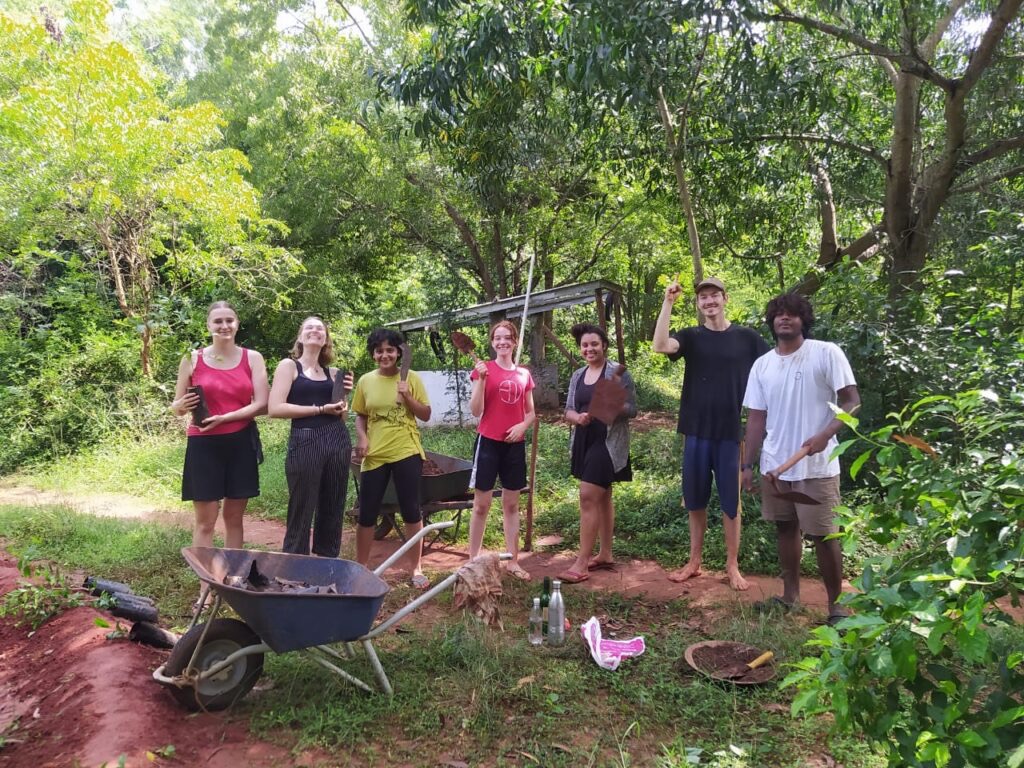
The Mango Field was first worked on by Ed Giordano who planted fruit trees, built a well, and constructed a home. Renu, the present steward, settled in 2002 and focused on planting hardwood intermixed among the faster growing acacia (the pioneering species introduced to build the first level of topsoil before the local varieties can be reintroduced). The stewards take care of the existing orchard trees (mangoes, chikoo, limes, etc.) by composting, but they do not have the financial means to do all the harvesting work. The area is more of an animal sanctuary, as human interference is kept to the minimum. In the last few years, Noe, a youth of Auroville engaged in forestry, has become an active member of the Mango Filed community and reforestation activities. The entire area has been bunded to prevent water runoff, and one big water-catchment pond has been dug.
Stewards: Renu and Isa
Contact: renu.auroville@gmail.com
Martuvam Healing Forest
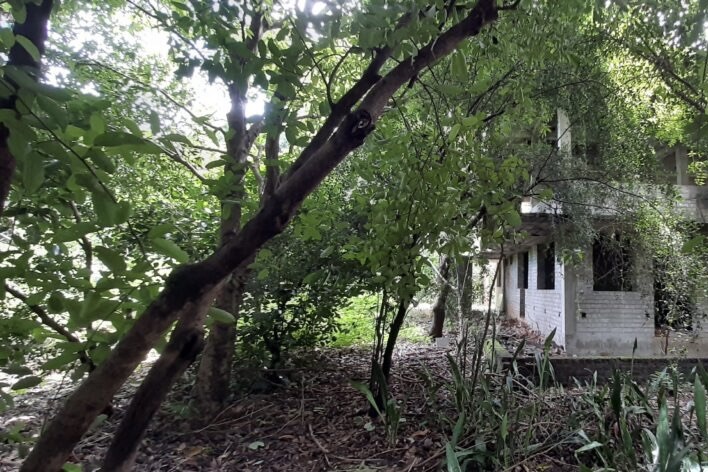
Martuvam Healing Forest is a 7 acre medicinal forest and garden in the western periphery of Auroville near the village of Annainagar. Beginning in 2002, Sivaraj, his wife and three children, and friends of Auroville have used traditional cultivation and harvesting techniques to turn their barren plot of land into a multi-dimensional healing center and educational haven. Martuvam has grown into a lush, natural forest and has provided the raw materials for the center’s herbal medicines. Martuvam is home to thousands of medicinal plants, bushes and trees of more than 100 varieties. Material from the forest and garden are used directly in medicine prepared at the Siddha&Ayurvedic Healing Center. Furthermore Martuvam is a place where villagers and guests can learn about the healing qualities of the plants. In the past the indigenous plants were used in daily life.
Stewards: Shivaraj
Contact: martuvam@auroville.org.in
Miracle Forest
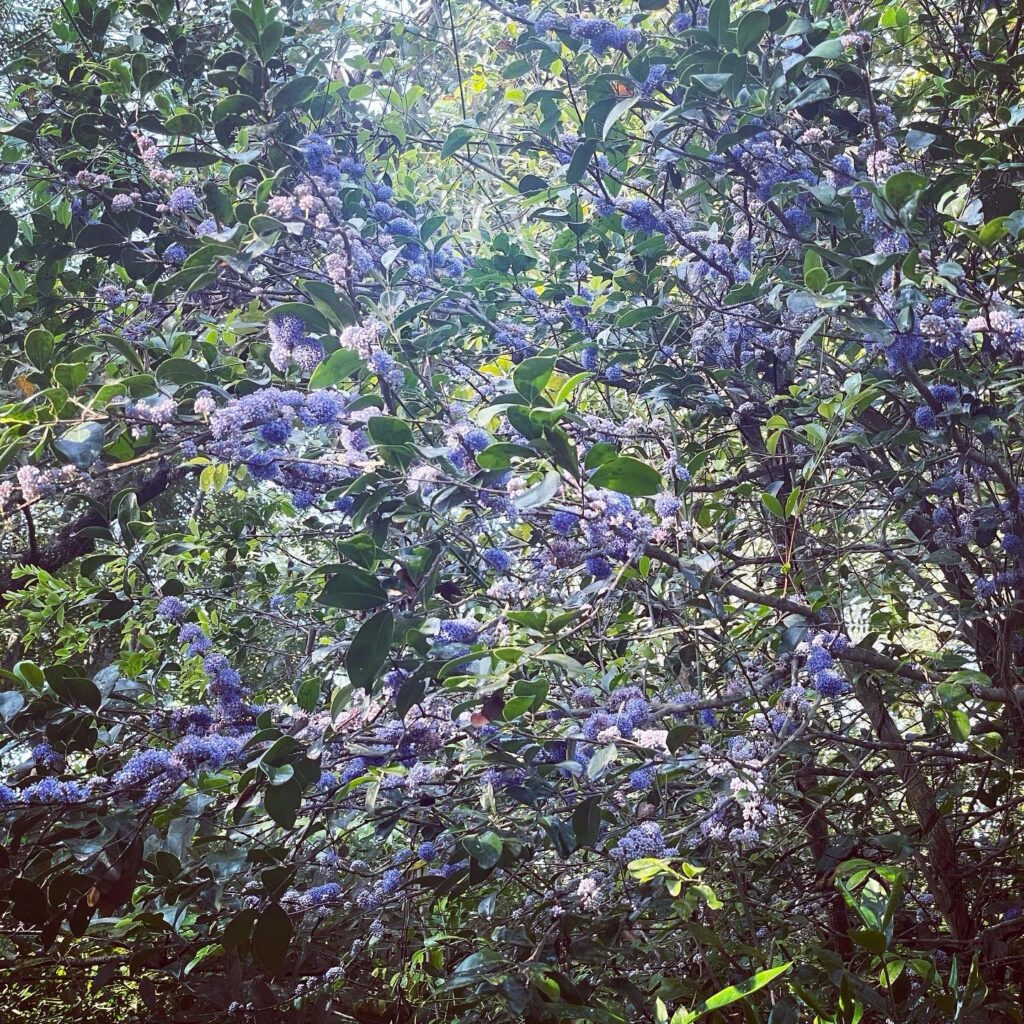
The first 5 acres of land of what was to become Miracle community was purchased in 1998. Miracle became a forest community in 2005. Enea and Sathyam, then youth of Auroville, were the first ones to settle on the land and do the initial work with minimum resources. Walter (from Shakti), George (from New Lands) and David (from Aurodam) were Enea and Sathyam’s mentors in their first years, and together they planted a mix of pioneering species with a particular focus on rare tree species of slow growth. Now the covered area is comprised of 25 acres, 8 of which are in the planned industrial zone of Auroville. All the land that doesn’t fall in the industrial zone is treated as a forest sanctuary with minimal human intervention, while the 8 acres that fall in the industrial zone have been reforested before the “outer ring road” was enlarged and are naturally regenerating.
Steward: Enea
Contact: eneaom7@gmail.com
New Lands

New Lands emerged out of the original lands of Forecomers and Success. The main goals in those early days were to work on rainwater conservation, tree planting, soil regeneration, and basic infrastructure to settle. Today, there is a small nursery as the land has been mostly reforested. The seasonal planting continues but the focus is on rare indigenous trees. New Lands is a supportive and thriving community. It has a variety of fruit trees, small vegetable gardens, all the community members participate in the upkeep of the work. The community uses only a windmill for their water needs and every household has solar power as the only source of electricity. One of the many accomplishments achieved through over 30 years of work is the consolidation of the once isolated forest plots into an almost continuous forest.
Steward: Phillip
Contact: newlandsregina@gmail.com, flip_av@yahoo.com
Nilatangam
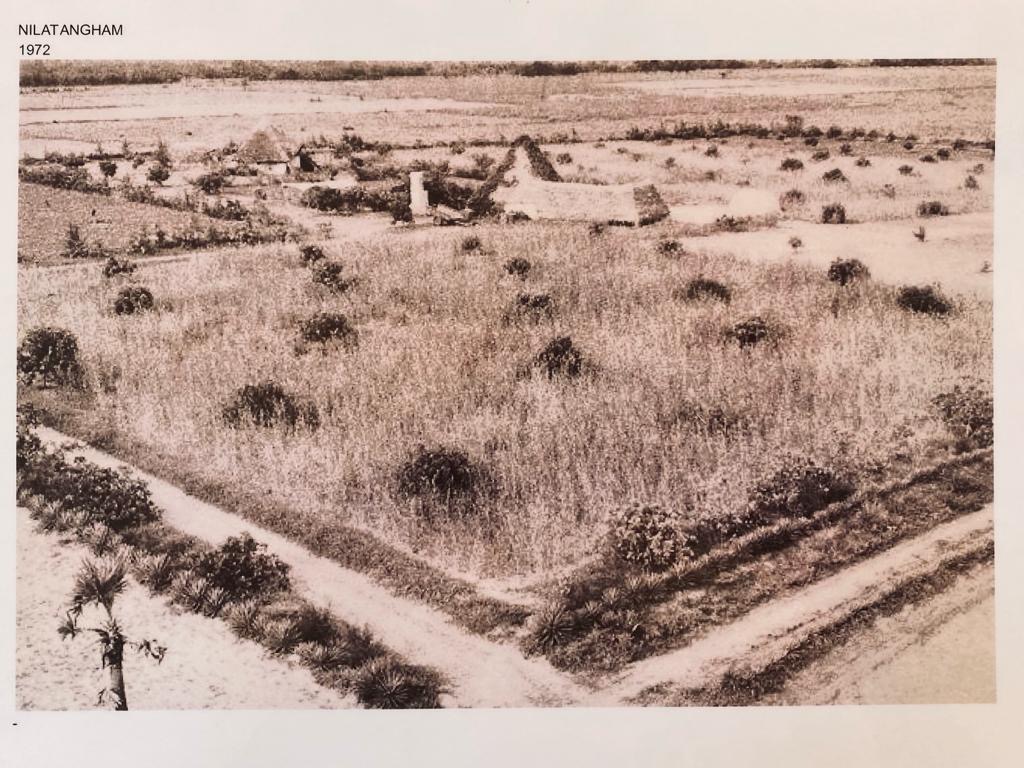
Nilatangam began as a mango orchard and farm with many animals, including cows, goats, ducks, chickens, horses, and a big vegetable garden. The first reforestation effort began by planting pioneer trees which are the initial species that create some topsoil before the indigenous varieties of the Tropical Dry Evergreen Forest – TDEF – can be introduced. Today Nalatangam has primarily focused on planting TDEF seedlings and between 2020 and 2021, 750 seedlings were planted both years. The main reforestation activity is almost done; there are still few smaller areas left to be planted. Now the work is to maintain the young forest by watering and mulching the young trees, cutting fallen trees, and fencing. Nilatangam has a small vegetable garden that is fully boar and peacock proof.
Steward: Ambre and Ancolie
Contact: eilocna@gmail.com, auroambre@gmail.com
Pebble Garden

Pebble Garden is an 8 acre plot on the northern edge of Aurobrindavan. The work on the land stands as a demonstration that it is possible to regenerate severely eroded land – heavily gullied, stripped of all vegetation and topsoil – into a thriving forest of native flora and fauna and productive farmland. This has been done with no external inputs of soil, biomass, or compost by the working hands of Bernard and Deepika since 1994, with no hired labour and a few occasional volunteers. The soil regeneration practices are shared on weekly open days for students, visitors, farmers, ‘back to the landers’ as well as through training programmes across India on soil and biodiversity conservation. The seed garden of 1000 sq m, all these years, has largely contributed to the seed revival movement in India. Deepika and Bernard gladly give seeds to Auroville Gardeners and farmers, school gardens and villagers.
Steward: Bernard and Deepika
Contact: pebblegardenforest@gmail.com
Pitchandikulam Forest
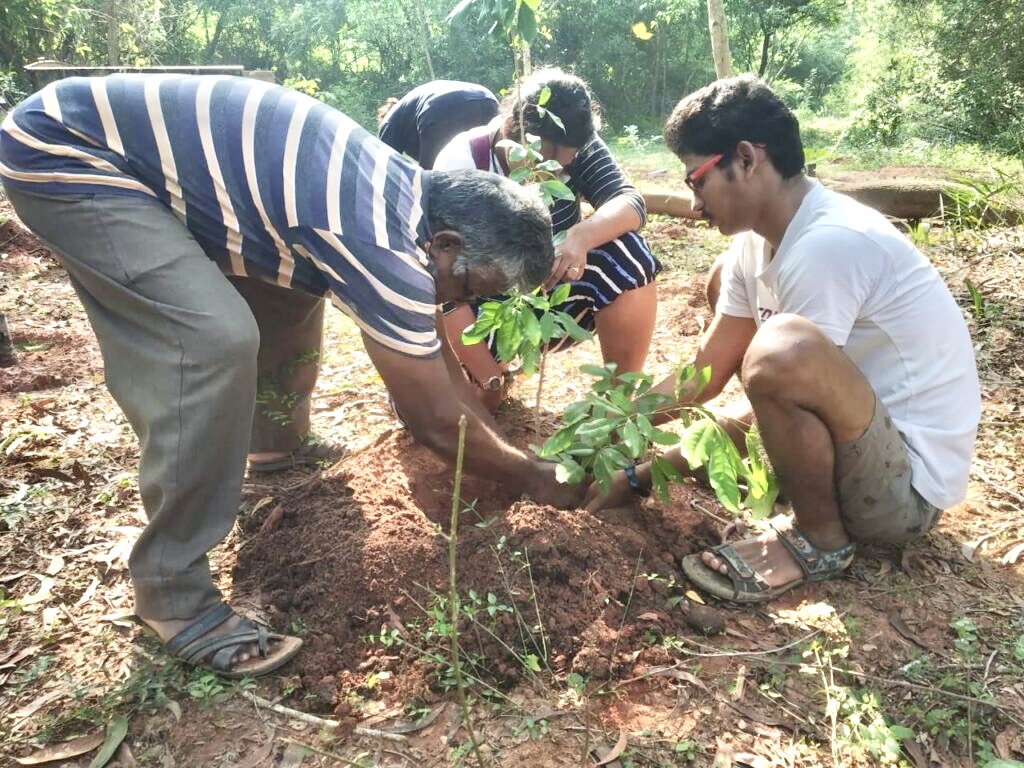
Pitchandikulam Forest was founded in the early days of Auroville when the land was dry and desolate. In 1973, restoration practices were set into motion using green manures to rebuild the soil. Live fences were created to protect the land from goats and cows, and pioneer species of acacia, leucaena, gliricidia, and eucalyptus were planted to provide windbreaks and shade. Today Pitchandikulam is a self-generating forest with a wide diversity of flora and fauna. There has always been a strong emphasis on conservation of indigenous plant species with a particular focus on medicinal plants and the people who use them. Documenting and celebrating the traditional knowledge systems and technologies of local people has always been central, as well as education activities in the schools of the bioregion. Pitchandikulam helps to provide models of sustainable ecological practices for the next generation.
Steward: Joss Brooks
Sadhana Forest

Sadhana Forest started in 2003 and it has been accepting participants from the first day of its establishment. Since then it has served as an educational experience for more than 5000 residential participants. One of the main efforts has been focused on experimenting in different methods of sustainable living, reforestation and water conservation. The project has held Permaculture courses, workshops, hosted school groups, students from India and abroad, and has helped train foresters from the India National Forest Department. To date Sadhana forest has successfully reforested 70 acres of highly degraded land with indigenous Tropical Dry Evergreen Forest and established a vibrant volunteer community welcoming over 1000 volunteers per year from over 50 countries. Beside planting and nurturing trees, another major project in Sadhana Forest is water conservation with the ultimate goal to reach zero runoff.
Steward: Aviram
Contact: india@sadhanaforest.org
Samridhi Windmill
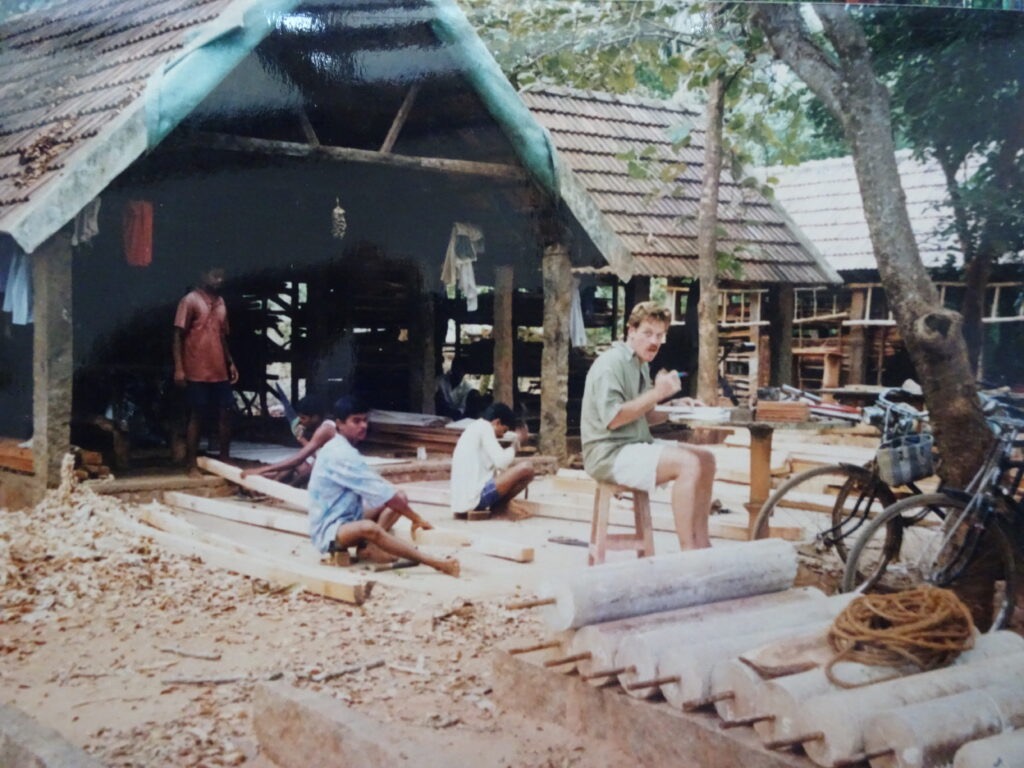
Samridhi Windmill was started by Jean-Marie and Biggie in mid 1970s. Diego, the present steward, moved in in January 1982. At that time the land comprised approximately 6 acres. In the mid 80s and early 90s more land was acquired and consolidated with the existing plots. One of the first projects in the mid 80s that was ventured in Samridhi, was the manufacturing of Windmills that provided not only the Aurovilian communities with an ecological and sustainable way to access water, but they were also manufactured and installed in other parts of India. In the early 90s, Aureka developed the metal windmill and so the production in Samridhi stopped. Today the water in Samridhi Windmill is still pumped only with the windmill; one of the few communities still relying only on it. Season planting occurs with a focus on fruits, cashews, and tamarind, all of which is coordinated by Mani.
Steward: Diego and Mani
Shakti

Shakti community and its nursery started in 1983, under challenging conditions, as initially there was no water, no electricity and no fence. Nursery work was started from the beginning, and a few years later, thanks to funding for the conservation and propagation of TDEF, it was possible to dedicate the nursery almost exclusively to raising TDEF species. In 1999 the Shakti nursery raised over 50,000 seedlings. In I981, the first issue of the ‘Auroville Index Seminum’ was published, listing all the seeds in Auroville available for exchange. The booklet was sent to the few Botanical Gardens known to the project at that time: just over fifty.
Steward: Walter and Luk
Contact: walter.gastmans@gmail.com, lgastmans@gmail.com
Siddartha Forest

Siddhartha Forest started on a plot of 12 acres in the beginning of 1998. Stewardship of the land has changed hands several times since then, but the focus has remained reforestation and water conservation. In its early days, many water catchment areas were dug, around 20 smaller ponds, plus a bigger dam was completed through the help of Kireet: an Aurovilian expert on water conservation. Boobalan, the present steward, came to Siddartha Forest as a youth from Edayanchavadi, the neighboring village. As a 13 year old he enjoyed planting trees, learning everything he could about forestry, as well as learning English and interacting with the diverse cultural background of the people staying in the community. Boobalan has been steward since 2014. Siddartha Forest has an established woodland that provides seeds for various communities, both within Auroville and outside enterprises. It is used by many as a Seed Bank as it has a large variety of trees and many rare species. The Auroville Botanical Garden and other Auroville forest communities visit Siddhartha Forest in order to collect tree’s seeds at least twice a year.
Steward: Boobalan
Contact: boobalanbullet@auroville.org.in
Silence

Silence forest started when the Master Plan was rotated. Silence was originally located where Bharat Nivas is now. More information about the early days of the forest can be found in the book “Better to Have Gone” by Akash Kapoor. Prominent early members who were involved one way or the other include Jocelyn and Jaap who now live in Ravena. The special feature of the forest is that it is rather old, and well protected, mostly due to a benign neglect. In fact, some of the trees may be close to 50 years old. There also is a rather large colony of bats living there. Dave, the current steward of the forest has an MSc. in Ecological Forestry and has been experimenting with the management of the forest. For instance, a part of the forest has been left as a ‘sanctuary’, meaning that it has been left as it is for the last 20 years or so, without clearing of thorns or additional planting.
Steward: Dave
Contact: david.n.j.storey@gmail.com
Udumbu
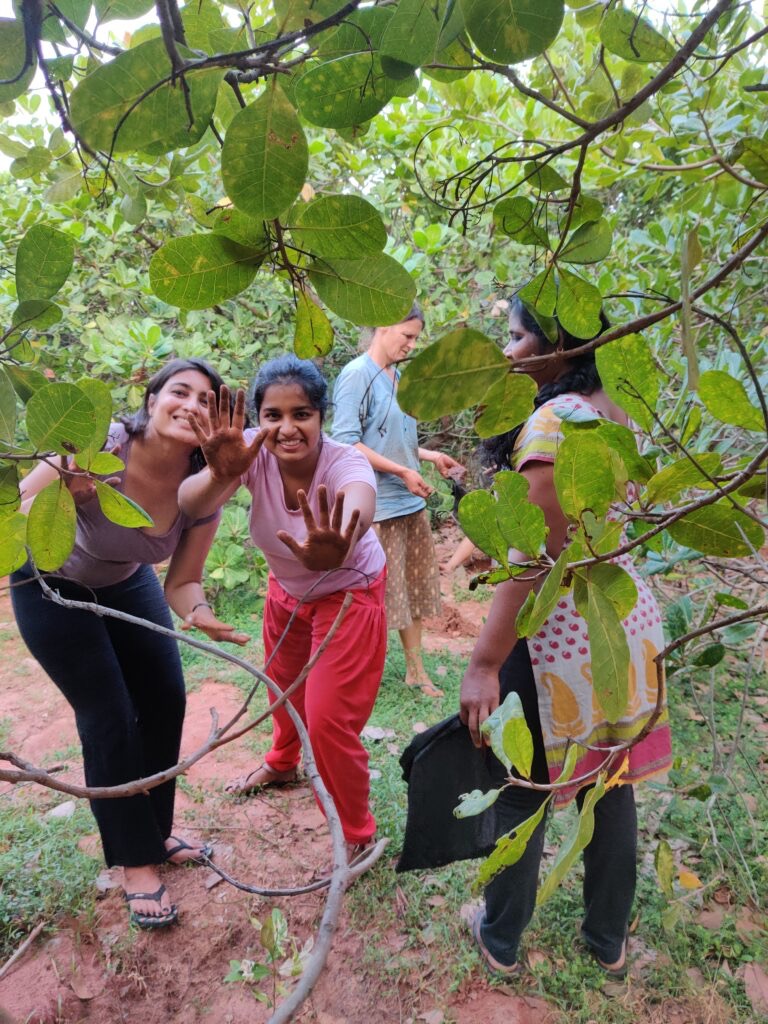
Udumbu is a forest community of 9 acres, started in 2000 by Aurovilians Steve (from the USA) and Sydo (from the Netherlands). The reforestation and landscaping was designed very scientifically, using experience and knowledge from the 1st generation of forestry projects in AV. It was proven through a systematic testing grid that additional compost made no difference to survival rates, but watering for 2 years during the dry season did. During the early stages of forest development it was possible to grow quite a good food crop, but once the canopy closed and roots were well established there was little scope for agriculture. There are some very productive lime trees and few other fruit trees. Udumbu sells or donates lime to PTDC and makes lemonade for community events like the Endangered Crafts Mela
Steward: Gijs and Jessamijn
Contact: ika.spoor@gmail.com
